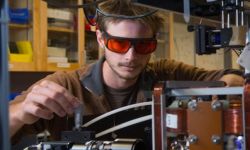
Matthew Norcia has been awarded a postdoctoral fellowship from the Erwin Schrödinger Center for Quantum Science and Technology (ESQ). As an ESQ postdoc, Matt will study dipolar quantum mixtures of erbium and dysprosium atoms in the RARE lab of Francesca Ferlaino.
In particular, Matthew Norcia will work towards greater understanding of supersolids formed from dipolar gases, on novel effects enabled by the combination of different dipolar species, and on extending techniques of microscopic control and detection to these exciting atoms.
Matthew grew up in Palo Alto, California, then attended Stanford University for undergraduate. There, he majored in Engineering Physics, with a particular focus on the design of electric vehicles. In 2012, Matthew moved to Boulder, Colorado, where he completed a Ph.D. in the group of James Thompson at JILA. During his thesis work, Matt built an experiment to couple strontium atoms to an optical cavity using narrow linewidth optical transitions. This platform enabled first studies of superradiant emission from the ultra-narrow “clock” transition in an ensemble of strontium atoms, non-destructive probing of atomic populations, a new method for spectroscopy based on “magnetically induced transparency,” and a new method of laser cooling that leverages coherent transfer of atomic populations for enhanced performance (called SWAP cooling). These achievements were recognized with the JILA scientific achievement award in 2016, and Matt’s nomination as a finalist for the Deborah Jin Award for Outstanding Doctoral Thesis Research in Atomic, Molecular or Optical Physics.
In October 2017, Matt Joined Adam Kaufman’s research group as an NRC Postdoctoral Fellow to build up a new experiment that uses optical tweezers to extend techniques of microscopic control to neutral strontium atoms. This new platform enabled ground-state cooling and high fidelity imaging of arrays of individual strontium atoms, as well as the demonstration of a new optical clock platform based on arrays of isolated atoms in optical tweezers.
In January 2020, Matt joined Prof. Francesca Ferlaino’s group at the IQOQI as a senior postdoc on the RARE experiment.